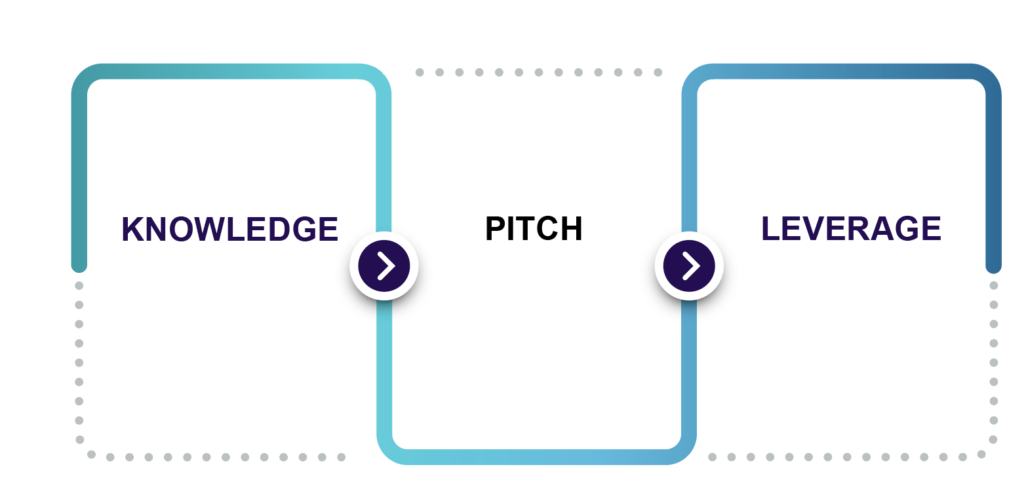How to Get Your First Consulting Client (Guide)

Learn how to qualify potential clients and conduct a needs assessment.
Understand the best methods for finding clients and how to pitch your business without sounding like a salesperson.
Confidently sell your approach and your rate and learn how to remove obstacles that may stand in your way.
Overview
Learn the critical steps to land your first consulting client. Qualifying your potential client is an important part of the process in order to make sure you have the skills and experience to meet the client’s project goals and decide if it’s a project you want to take on. Understanding how to sell your services and what differentiates you from other candidates is key to winning the deal and will help you understand how to market your services effectively.
GATE
In this guide, you will learn:
How to qualify your client
When you start a consulting business, selling is certainly one of the most difficult tasks at hand. For some, selling wisely comes naturally, but for others it can be the most frustrating part of working as an independent consultant. Whether it’s because we feel underqualified for the position or because we have simply never done it before, we still need to seal those deals—and to do that we must sell.
Qualifying is a critical step in the sales process, and it will save you a lot of hassle and headache as you deal with new clients, helping you reach independent success quicker and easier.

What is Qualifying?
In simple terms, qualifying is figuring out what the client needs, how your business can meet those needs, and how likely it is that a client will employ your services.
Qualifying (v.): Developing a conditional understanding of a potential client and their needs to increase the probability of closing the sale.
The goal is simple: to make sure there really is a good business fit between what consulting services you have to offer, and what the client is willing and able to buy.
Ask these qualifying questions
By asking a series of qualifying questions, you will immediately know whether you can meet the client’s needs. If your services are not in alignment, you will be able to quickly identify that this is not a highly probable opportunity and you can move on to another lead.
- What is your client’s current situation?
- What need do they have?
- What would they like to see from a solution?
- How can your consulting service help them get from where they are to where they would like to be?
Conduct a needs assessment
Begin by asking broad questions to determine the potential client’s understanding of their own needs. The conversation will naturally grow and develop and eventually, you should organically come to discuss their specific needs—be open and understanding, encouraging them to explain and share in detail. This step will not only help you understand clearly their situation, but it also allows them to conclude that their situation is significant enough to take action. It gives them an opportunity to hear their situation aloud and to confirm the need for action in their own voice.
Once your potential client has answered these (or similar) questions, you will get a plethora of information that allows you to tailor your sales pitch to every customer, ultimately winning you more deals. Further, understanding their budget (and ability to pay) will help you calibrate the right consulting rate in your proposals.
Qualifying doesn’t just stop there. In addition to pitching to more promising leads, it also attracts new prospects. Sharing your qualification process with your clients shows an honest and transparent business practice and gives your clients confidence from the outset. After all, the search for the perfect fit between client and consultant will benefit all sides if conducted earnestly.
Sample Needs Assessment Questions:
- Would you describe what your current environment looks like?
- What does your ideal situation look like?
- What is your six to 12-month strategy?
- How much is your problem currently costing you?
- What is your budget range for this project?
- What kind of growth are you anticipating from your ideal situation?
- Who in your organization is the primary point of contact for this consulting project?
- Have you worked with consultants on this project before?
- What worked, or didn’t work, for you in that scenario?
How to land your first client

When you make a decision to become an independent consultant, one worry may dampen your excitement: landing your first client. Your strategy should be twofold:
- Ease a client’s fear of using a new or unproven consultant on a project. Accomplish this by creating solid examples of great work, compiling strong references, and developing a winning online profile.
- Ease your own “inner voice” of doubt by preparing and planning well for marketing strategies prior to your launch.
1. Get industry knowledge
You may be good at what you do, but are you “plugged in” to how independent consultants operate in your industry space? While you’re considering the transition, gain as much knowledge about your industry as you can. Check, and contribute to, online forums and professional sites like LinkedIn. These sites are excellent places to share your expertise and network. By exchanging knowledge, you can build credibility before you head out on your own. People will begin to regard you as a trusted source of information in your industry. The goal is to become the top-of-mind resource for projects in your field, and also learn from others that are offering services.
2. Ease into your sales pitch
How important is a practiced pitch to winning new business? Whether or not you begin with preparing a pitch, a successful result often includes the ability to articulate your value proposition at the right moment in a conversation—and the ability to network your way to success by authentically connecting with others in a personal setting. A pitch alone will not achieve results.
Ninety percent of all independent consultants find their first contract through their personal and extended network. This means making announcements that you are looking to work with those who know you, or in other words, networking—not pitching. When you meet someone for the first time, shake their hand, look them in the eye and introduce yourself and have them introduce themselves.
After that, ask what they do. At this point, you can separate yourself from everyone else in the room by asking them more specifically what they do. Use the information they provide to talk about what you do in context of their role.
Remember to:
- Be concise in the description of the “what” and “why” that differentiates you.
- Stay targeted to the specific niche or role they play in their position.
- If possible, tell a personal story. Stories are memorable and can make your experience come alive.
- Meet more than one person. Work the room and make it a goal to talk to and get to know several people. Some events have an advance list of attendees. Review the list prior to the networking meeting to identify people you’d like to connect with at the event.
3. Leverage Past Employers
Many consultants find their first project through their past employers. If you have informed your employer of your plans to transition to the independent workforce, consider having a frank discussion. Your employer may be open to the idea of hiring you as a consultant to continue to do the work you’ve already been performing. Be warned—this is a tricky situation—your employer may perceive your request as an elongated notice period. To win over your employer, you need to present a case for how this change will be beneficial for both parties, so do analysis and develop a proposal for a new working relationship prior to your meeting.
This is why it is so important to never burn bridges. Your employer can become your first client and/or a source for future work.
90% of all independent consultants find their first contract through their professional and extended network
How to sell your expertise
Before you can open the door to a deeper discussion, the client must first believe that you have the credentials and experience to meet their needs. To sell your first client, be prepared to speak to your experience, level of seniority, and specialized skill. It is important to realize that this phase may take place with or without you. For example, a former colleague may refer a potential client to you, providing them with your contact information. That prospective client might check out your LinkedIn profile before they ever call you.
Whether you meet your first client through referral, networking, or a chance meeting, find out as much as possible so that you can talk about your relevant skills and experience in alignment with their needs.
Be prepared to share your:
- Experience
- Level of Seniority
- Specialized Skillset
1. Sell Your Approach
After you have opened the door you will want the client to see that you are the problem-solver or expert specific to their gap or pain point. This requires putting your expertise to work by diagnosing and providing a framework for solutions. This phase of landing your first client can take place in several stages. You may have an initial meeting or two that allows you to conduct a needs assessment followed by a written proposal. How you diagnose the problem and approach providing a solution are integral to winning the business.
Selling your approach may not happen in one meeting. In some organizations, you may have evaluators and approvers. The process could take several weeks or even several months. This is why it is vital to have more than one opportunity in your pipeline, even as your business matures. A steady flow of opportunity will ensure that your well never runs dry.
2. Sell Your Rate
Finally, you need to seal the deal. In this phase, you will want to remove obstacles that may be preventing the client from taking that final step. As a new consultant, this is where you may consider your pricing strategy. The client should feel that they are getting access to a valuable, specialized skill set and experience for an introductory rate. Be honest about being new to consulting and leverage that to secure your first deal. Let them know you want good references so are willing to do a special deal with them to get started. You need to position this in the right way and not give away the farm. For example, you can offer to do the project for x dollars and then offer an extra benefit such as a small discount or supplemental service. People need to feel special, and if you’re looking for a client to take a risk on you as a brand new consultant, give them a little bit of incentive. You can always readjust your rates in the future.
3. Choose your clients wisely
As you work to land that first deal, remember that it is also important to carefully vet your potential clients. Be sure to match your expertise to their needs. It can be tempting to oversell your capabilities to get that first deal, but doing so can damage your credibility.
Make sure that your client has access to funds to pay you and has a good track record of paying invoices on time. You can use D&B to check your client’s credit rating and use online forums and reviews to see what other consultants and vendors have had to say about the client. When you work with an MBO client, we also handle the collections process for you, helping free up valuable time that could be spent working forward on other client projects.
Once you land your first client, you can use that to create a pipeline of opportunity. It is not uncommon for other opportunities to crop up while working on a project. Maintain focus on your defined scope of work, but do keep notes so that you can address the additional opportunities after completion of your original project. Once you have completed your deliverables on a project, prepare a list of additional tasks that could be done. You can obtain future work by presenting these details to your client in an organized way. You can even begin discussing opportunities for additional work three to four weeks prior to the end of your contract.
Effective networking requires you to listen to what others are saying and seek ways to meet their needs. If you are not qualified to help, be a resource by making a referral to someone else.
How to network effectively
Networking and selling yourself are critical for the solo business owner. A go-to network of relationships can guard against economic uncertainties by providing high quality referrals ready to buy. Networking and selling are not only important for landing your first client, but also for ongoing success. It is crucial to dedicate effort even if your books are full. Without neglecting your current projects, you should have a constant flow of choices and opportunities to avoid the “feast or famine” cycle. You also want to ensure that you do not have all of your eggs in one basket. If you lose a client or a project ends, you do not want to be left scrambling for new income.

Take Your Networking Online
Speak directly to people who are interested in the same things you are, and leverage word of mouth referrals to win new consulting clients. To brand your business online, you should be on LinkedIn, Twitter, Instagram and TikTok.
Your professional profiles should contain all of the important information your clients may need, and must be updated with current content. Be careful to always keep it professional when it comes to your business profiles, and maintain a consistent “personal brand.” It is also good “net”-iquette to ensure you are not spamming all of your social networking contacts at every opportunity. Find a balance between sharing what is interesting to you and what is related to your business. Be a sensible social networker!
While the ultimate goal may be to reach customers or clients, the contacts that you make through networking on social media may be potential suppliers, industry influencers, or even media members. Your personal image and reputation play a major role in determining the opportunities that will come your way when you don’t have a company reputation to fall back on.
Use social media accounts to:
- Network with others
- Promote your business
- Create awareness of your products and service
Once the “house is in order” from a social media standpoint, creating a professional business website is a must.
Looking for work as an independent consultant? Join our marketplace to search for your next project
Related Posts
Trending
Subscribe to our blog
Get a weekly email of our latest posts sent straight to your inbox
Learn more about the MBO Platform
FOR INDEPENDENT
PROFESSIONALS
Start, run, and grow
your independent business with MBO
FOR
ENTERPRISES
Engage, scale, and optimize
your independent workforce


